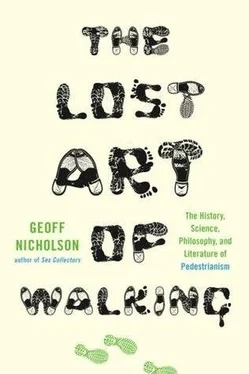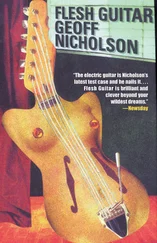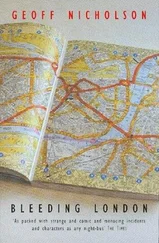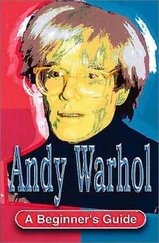‘Of course I’ll get lifts’, I said.
My father thought about this. ‘Well, I hope so’, he said. ‘I mean, if you had to get from here to London’ — ‘here’ was our home in Sheffield, in the north of England, 165 miles from the capital — ‘then I suppose you could get there eventually just by walking. But getting to California, well, it’d take you forever’.
And, of course, I did get lifts, plenty of them, some of them colorful, only one of them with obvious lethal potential. I’ll spare you most of my hitchhiking stories, but the fact is, when you hitchhike you do a lot of walking, far more than you want to. You get dropped off in places you don’t want to be, in places where no other car would ever stop to pick you up. So you walk on to the next crossroads where more traffic joins the road, or to a nice long, clear stretch where a car can pull in easily, or two miles farther to a field where you can sleep for the night.
My best hitchhiking and walking moment came somewhere in semi-rural Oklahoma. There was a bleak, empty highway on my left and weed-strewn railway tracks on my right, and I admit that my memory may have made the image a little more cinematic than it really was, but the story is as true as I can make it.
A long way up ahead I saw an old black man walking toward me. He was lean, loose, in work clothes. His walk was solid and serviceable, but so very weary-looking. We were approaching each other for a good long time and we made eye contact long before we got within hailing distance. When we finally came face-to-face the old guy said, ‘I wish I was where you just comin’ from’. I’ve spent a lot of time over the years trying to think of some witty thing I should have said in reply.
♦
Eventually, and a little reluctantly, my hitchhiking took me to Los Angeles. Even before I’d left England everybody had told me that L.A. was impossible without a car, and I saw no reason to doubt them. I’d even read Kerouac’s opinion, in On the Road , that ‘Los Angeles is a jungle’, and though I certainly wished he’d come up with a more interesting metaphor, I again thought it was probably true.
♦
There are plenty of lacunae in my memories of that first visit, but I do remember the lift that took me into L.A. The driver, who looked like a hippie from Central Casting — bearded, mellow, soft-spoken, and pretty well-heeled, judging by his car — proudly pointed out as we approached the city that we were driving on a twelve-lane highway, and he made a detour so that he could drive down Sunset Boulevard and show me the Strip. He was especially keen that I see the huge billboards, and as I remember it they were of the Marlboro Man, Peter Frampton, and Joe Cocker, but again, time may have buffed up these memories.
My new pal dropped me off on Hollywood Boulevard, at a fleapit that called itself a ‘motor hotel’, and even so cost far more than I could afford. I’d hoped that somewhere along the way I might have been befriended by fun-loving hippie chicks who’d invite me to stay in their commune in Laurel Canyon, but that hadn’t materialized.
Hollywood Boulevard was a scary place in the mid-seventies, though no doubt I scared more easily then than I do now. There were a lot of people on the street who looked somewhat like hippies, but you could tell they weren’t the mellow, peace-loving type of hippie. They were only there for the drugs and the sex, and you just knew they wanted bad drugs and bad sex.
And there were a lot of hookers, of both sexes, but predominantly male. Thanks to John Rechy, we now know that the real industrial-strength action was taking place not on Hollywood Boulevard but half a block south on Selma. The main drag, however, was quite action-packed enough for me. The hustlers walked up and down, wearing their cowboy hats and fringed suede jackets, looking like extras, or perhaps leads, from the movie Midnight Cowboy , or more feasibly Warhol’s Lonesome Cowboys . As a matter of fact, I owned a fringed suede jacket at the time, and I was glad I hadn’t brought it with me to America.
I remember seeing a street musician standing in a doorway somewhere near Vine Street playing a saxophone, and I stopped to listen to him. He had a great act. He’d start out playing a recognizable version of ‘My Favorite Things’, and then veer off into ever wilder improvised Coltrane-style free-jazz squawking, until he fell on his knees writhing with the intense emotion of it all. Then he’d stop, stand up, and do it all over again. It impressed the hell out of me.
I did by chance meet a fun-loving woman who had a couple of tickets for a David Bowie concert at the Hollywood Bowl and offered me one of them, but the journey there seemed unimaginably difficult to both of us. We didn’t have a car so we thought it was impossible.
Now I look at the map and see that you can walk from Boulevard to Bowl quite easily in half an hour at most, and I suppose a bit of careful map reading would have told me that at the time. But I believed the myth and the hype, that you couldn’t get anywhere or do anything in L.A. without a car, and you were wiser not to try.
♦
Three decades later, newly arrived in Los Angeles, I was ready to defy the wisdom. In the name of self-medication I began to take regular, long, sometimes arduous walks in L.A. In fact there are a few places in and around the city where people go walking: Griffith Park, Runyon Canyon, Venice Beach, the shopping streets of Beverly Hills, Santa Monica’s Third Street Promenade, parts of downtown. A long drive may well be involved in getting to any of them.
There was something a bit obvious about walking in these places, but I didn’t want to be completely self-denying or self-punishing, so I walked in all of them. Then, since I was living in a movie town it seemed natural enough to visit some movie sites: places where Hollywood stars lived or at least had lived and, in some cases, died. Is there any other city in the world where you can buy maps and guides telling you the locations of the homes of its most famous living citizens? I bought several.
If the data were to be believed you could, for instance, walk along Franklin Avenue, a largely unsung street, where Dorothy Dandridge had lived before she went bankrupt, where Gary Cooper had lodged with his parents, where Joan Didion had lived in her yellow Corvette period. Live stars were a bit thin on the ground on Franklin, however. For them it was recommended that you go to, say, Aldercreek Place in Westlake Village, where you could saunter past the home of Frankie Avalon, or to Folkstone Lane in Bel Air, where Tony Curtis lived, or to Cornell Road, the Agoura Hills site of chez Kelsey Grammer.
Once you started walking in Beverly Hills, the famous, and the ghosts of the famous, were to be found on every street: Greta Garbo on Chevy Chase Drive, Barbra Streisand on North Bedford Drive, everybody and his uncle on Roxbury: dead legends such as Lionel Barrymore, Lucille Ball, and Dorothy Parker, and live ones such as Mia Farrow and Peter Falk.
Inevitably these walks of mine didn’t result in my seeing any movie stars. In many cases I didn’t even get to see the houses because of high walls and hedges, and signs promising an armed response. But if you’re the sort of person who’s moved by the notion that somebody famous is (or was) here, then there’s still a frisson to be had from looking at movie star homes. And some days, I’m that sort of person.
My star maps told me not to go knocking on doors and bothering the stars, and I didn’t, and in a lot of cases I wasn’t even sure the information was accurate. I felt sure that movie stars moved more often than these maps were updated. Which brings me to the story of the time I walked with Christina Ricci.
Читать дальше












